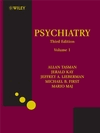Mood Disorders: Bipolar (Manic–Depressive) Disorders
Summary
Manic–depressive disorders are recurrent, major mood disorders that, if untreated, lead to substantial morbidity. Neurobiologic and psychosocial models have been applied to explain their occurrence, course, and treatment. While modern treatment evidence supporting a neurobiologic component is incontrovertible, the illness is best understood in terms of Engel's biopsychosocial perspective. State-of-the-art treatment extends beyond simple symptom reduction. Rather, management should focus on three outcome domains: clinical outcome, functional outcome and subjective quality of life, and illness costs. The mainstay of treatment is combined somatotherapy and psychotherapy. Lithium is currently the only agent to have placebo-controlled Class A data to fulfill the fourfold definition of a mood stabilizer, while an increasing number of other agents have demonstrated ability in one or more treatment roles. Side effects to treatment are the rule rather than the exception and require active medical and psychotherapeutic management. Several psychotherapeutic modalities have been demonstrated to be efficacious as adjuvants to pharmacotherapy for manic–depressive disorder. Most of these utilize cognitive and/or behavioral components and share the common agenda of educating patients to improve self-monitoring and self-management skills. Attention to system factors that can inhibit or support effective care should be included in treatment planning. Evidence supports a collaborative approach to treatment planning, in which the clinician is the “treatment expert” and the patient is the “values expert” in choosing among a variety of evidence-based treatment options.



